A growing population of endurance/ultra-athletes and coaches are moving towards StrongFirst programming. These athletes and coaches bring questions on program design utilizing Strong EnduranceTM protocols. In this article, I will share the snatch walking plan I’ve designed using one of these protocols. Most of my students use this plan at the end of many months of protocols from The Quick and the Dead by Pavel. However, one of my students, Mia, utilized it at the beginning of her training so she could achieve a greater benefit from The Quick and the Dead protocols that my other students start with (side note: Mia will be attempting multiple speed records on Mt. Aconcagua—more on this later). Determining whether you should start with snatch walking or finish with it is a matter of your training history. Let’s take a closer look at this by covering a few examples.
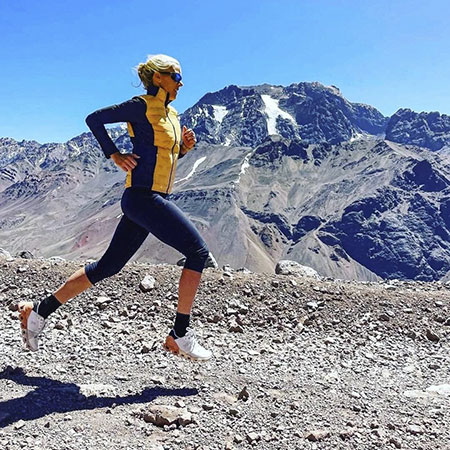
Building Endurance Without the Miles
First, it’s important to understand that building a high level of endurance capacity is about more than simply putting on miles of training. Let’s think about one aspect of endurance by considering a hypothetical deadlift competition. The first competitor has a maximum deadlift of 400 pounds, and the second competitor’s maximum is 600 pounds. Who can perform more repetitions at 300 pounds without dropping the bar? Without a doubt, the person whose maximum is double the tested weight would find this test significantly easier. Does this person have better muscular endurance, or does it just seem that way because the tested weight is more submaximal to them? Honestly, it doesn’t really matter. The truth is they would easily perform better at the test. This might sound like an extreme example for endurance athletes, but it really isn’t as far out as you’d think. Collin O’Brady, the first to cross Antarctica unassisted on foot, began his trek pulling a sled weighing over 400 pounds.
A real example of this type of endurance is John Brookfield’s “Tower of Terror.” This consisted of snatching a 48kg kettlebell, locking it out bottoms up, and flipping it twice on the way down before catching it and snatching again. He did this for 20 repetitions. John also performed more than 300 repetitions in a 10-min snatch test using a 24kg kettlebell. Yes, that’s 150 repetitions in a 5-min SFG snatch test twice back-to-back. At that pace, a 10-min kettlebell snatch test could be considered similar to running two miles as fast as possible. This isn’t an ultra-athlete performance like Collin’s, yet again, because John is so strong, he can outperform most people in this 10-min test of endurance.
If you’ve always looked at building endurance through many miles of training, perhaps these examples have begun to catch your attention. However, let’s explore a real ultra-endurance example and how this snatch walking plan began. After listening to Pavel present Strong Endurance, on four separate occasions, I began to see a way to build capacity for ultra-events by putting his protocols into a progressive order. This order started with the heaviest weights, lowest volume, and lowest density. It built toward lighter weights, higher volume, and greater density. This progression seemed natural to me, because I have a strength background and wouldn’t have been able to jump directly into the more enduring protocols without building toward them. Therefore, my personal program concluded with the snatch walking progressions. After six months of training, I was able to run 3 x 7-minute miles (7-min rest between each) while breathing entirely through my nose. This may not seem extraordinary to an elite runner, but I hadn’t run throughout the entire six-month plan. I also tested my new endurance in the mountains, accomplishing seven peaks in eight days. These mountains were all over 13,700 ft. The effort pushed over 26,000ft of vertical increase and covered 65 miles. This caught the attention of a few of my students who also wanted to summit these aggressive mountains. They utilized the training plan and conquered their objectives with ease.
Working Backwards
After these expeditions, I was thrown a twist. Mia Farrow caught word of my programming through her trainer, Peter Kirk, in Australia. Mia will be attempting 3-4 world records (some will be the fastest known times or FKTs) on Mt. Aconcagua next month. At 22,837ft, Aconcagua is the second tallest of the world’s seven summits. Mia’s main objective will be a 110km event that crosses the summit, while also circumnavigating the mountain. This task will be done in one push of 35-47 hours. The twist, for my programming, was that Mia wasn’t coming from a StrongFirst background. Instead, she had a very large endurance background. I felt she wasn’t quite strong/powerful enough to perform the protocols in the order I had designed for myself and my other students. However, the high volume, high density, and lighter weights of snatch walking was a comfortable place for her to begin.

Plans like 015, 033, and 044 (read The Quick and the Dead for more information on these) would have had less impact if we started with them. She was unable to swing or snatch a large enough weight to effectively recruit the correct muscles and energy system needed to build capacity the Strong Endurance way. So instead, we started her with the most enduring protocol (snatch walking) in order to play to her strengths. We worked backwards in the progression, slowly increasing the weights she used while decreasing the volume and density. After a high volume of snatching 8-10kg, it was an easy transition to snatching 12kg and even 16kg in Plan 044. This also allowed us to jump even higher when changing from snatching protocols to swing protocols. By the time she got to Plan 033, Mia was swinging 28kg. She didn’t actually have a 28kg kettlebell, so she did asymmetrical two-arm swings with 12kg in one hand and 16kg in the other, alternating hands each set. This allowed her to work on anti-rotation and stability. Considering her sport, offset swings were an effective addition. Having a greater load on one side has a large carry-over into carrying an odd pack while traversing the side of a hill or mountain. Had we started with Plan 033, a 16kg kettlebell would have been her choice, and it would have had a smaller impact on building strong endurance.
Time will tell whether she gets these records, but, for now, her hip power is better, she’s stronger, her joints are more stable, and she’s primed for success (side note: Mia also continued her run training throughout this process).
Even though Mia started with the snatch walking protocol, and my other students ended with it, I’m excited to bring her back to it after her expedition is complete. She is now strong, first, and will likely gain even more benefit from snatch walking now that she feels 8-12kg is significantly lighter.
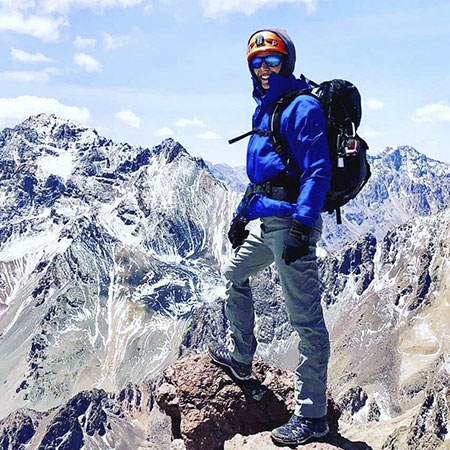
The Snatch Walking Protocol
Let’s dive into the procedure.
Kettlebell size:
Men—12kg to 20kg
Women—8kg to 12kg
Method:
Snatch the kettlebell, lower it from the lockout to the rack position, take one step forward, drop the kettlebell from the rack, and then snatch again. Repeat. Switch hands every 5-10 repetitions.
Stop if you:
- Cannot pass the talk test at any point.
- Feel an RPE greater than 7 on a scale of 1-10.
- Lose the ability to breath in on the hike pass and out when the hips finish each rep
(breathing during the rack or forward step should be natural).
- Change your technique in any way for any reason.
- Reached your time limit for the session.
The first progression time limit is 25-min.
Perform this protocol 1-2 times a week. If you do it two times a week, always do 20% less in the second session.
Measure your distance—you’ll find this easier than counting reps.
When you can reach the 25-min time limit without hitting a stop sign, and your distance has increased by 10% beyond the last 25-min session, increase the following week’s session to a maximum of 40-min.
When you can reach the 40-min time limit without hitting a stop sign, and your distance has increased by 10% beyond the last 40-min session, increase the following week’s session to a maximum of 50-min.
Once you’ve built a comfortable capacity for 50-min, go back to The Quick and the Dead training Plans 033/044 before further progressing the snatch walk plan. The simplest way to progress this plan is to perform an overhead carry, rather than a racked carry, in between repetitions.
I’ll be heading to Mt. Aconcagua, in Argentina, to watch Mia attempt her records. I’ll also personally continue testing Strong Endurance training methods by attempting a summit of the mountain myself. Upon return, I’ll be excited to publish a recap of the events here. Stay tuned.
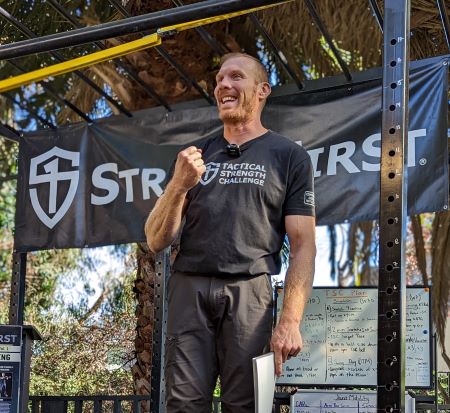
teaching an All-Terrain Conditioning™ Course
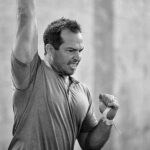


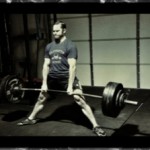




Hi Derek,
What is the rack position, and what is RPE?
Rack position is where the kettlebell finishes in a clean.
OK. Wow. I haven’t been well for a few weeks and would like to get my endurance up again.
I was thinking of doing Easy Strength but replace my walk with something like this with a light kettlebell.
So I see from this article that the rack carry is “money”. I could do a 30 foot rack walk, press jerk, clean down to the floor and swap hands then repeat?
Hey Graham,
This sounds more like a carry day protocol. I believe I wrote a newsletter on this, but not an official article. 30-75 minutes is a good time to focus on for carry protocols.
What kinds of shoes? I usually snatch in Converse All-Stars which aren’t really designed for long walks. In the photo it looks like she’s wearing running shoes with thick soles, which I thought you’re not supposed to wear for KB stuff.
Hi Ron,
All-Stars would be okay. I use Xeros. Barefoot would even work. You really don’t walk all too far (1200 steps tops). As far as Mia, she is sponsored by ON, hence the pic. Any time she’s photographed for promotional reasons, she is featured in her sponsor’s gear.
I have Vans Ward which is similar. As far as footwear goes it is important to get it right. I would recommend barefoot first, socks second then any sort of basic flat shoe third. Stability is the key. Any sort of squishy trainer is a health hazard especially for a workout like this. Too much movement. I have stiff walking shoes which would be just as bad ironically. You can’t feel the ground when wearing them at all but for hiking they have great protection and grip. You need strong feet for strong legs!!!!
Great approach to endurance training for runners, and sport that has your feet on the ground. In regards to cycling, I am hesitant to believe this protocol would improve my ability to cycle longer and/or harder. I know hip power will increase but that doesn’t do much for a cyclist in terms of forward propulsion. (Simply because of body position ion on the bike) Most of that is due to quads, hamstrings. So I guess the hammies would see some transferable improvement but I would love to know how this transfers over to a competitive endurance cyclist.
Thanks!
Yes, excellent observation. Other than HR benefits, I agree there wouldn’t be much transfer. For cycling, I would rotate between plans like 015, 033, 044, and possibly 060.
Hello,
What is your take on regular and more traditional LISS training with rucking or running ?
Thanks !
I follow one of two heart rate specific protocols, once a week, utilizing step-ups. These protocols are highlighted in All-Terrain Conditioning. I feel step-ups and snatches translate into the mountains more than any other two exercises.
Great article, thank you. I do have one quick question. When stepping forward, are you alternating left/right leg, with the bell in one arm for 5-10 steps then switching? (or only one leg then switching with arm?) Thanks again!
Great question. At first, I would snatch right and step forward left-right. Then snatch left and step forward right-left. Perhaps I got bored, or perhaps I wanted to test imbalances, but now I alternate steps.
Thanks Derek!
Great article, thank you Derek!
If only runnng it once per week, would you continue with 044 or 060 alongside it 1-2x per week?
Good luck with the WR attempt!
I utilize plans like 044 and 060 as progressions to this plan. Along with snatch walking 1-2 days/week, we have 1 pure strength day, 1 isometric hold day, 1-2 step-up HR days. As mentioned, this protocol is usually implemented at the end of our training cycle. Post world record attempt, we’ll be headed home, and starting over with a very heavy 015, a couple strength days, and a carry day.
Good luck!!! Sounds amazing. I watched 14 peaks and Purja threw a big rock about. Will you be doing that as part of your plan? 😂
Any recommendations for how to select the appropriate weight? Personally I can one hand swing the 48kg pretty easily (sets of 10-20) and have passed the 5 min snatch test @24kg.
Would it be better to do this as a stand alone session? Or after strength training? If after – better after an upper session or a lower? I’d separate, minimum time between a snatch walking session and a strength training session?
Give a 16kg a try to start. I keep my strength sessions on separate days, but might consider it after a minimalistic pistol squat day.
Thanks Derek! I’ll give it a go. It might replace 1-2 of my weekly runs for the next few months.
If due to technique and mobility issues, is it feasible to replace snatch with either swings or clean&jerk/clean&press to receive similar benefits?
Swing walking is very difficult. Perhaps a moderately heavy clean could work, though
But not with a jerk/press?
OK this is clear:
“Snatch the kettlebell, lower it from the lockout to the rack position, take one step forward,”
but for this??
“drop the kettlebell from the rack, and then snatch again. ”
does that mean drop the KB to the ground and shake out the tension? Or does does that mean drop into the hike and start the next rep? Is there any kind of rest in this protocol, or is it ‘one long set’ until time expires?
no rest try to endure to the time goal. stop before time limit only if you encounter one of the STOP signs listed. do not drop KB, leave rack to go into next snatch motion. Alternate hands every 5-10 reps. it is an endurance training after all 😉
Yes, sort of. The micro-pauses between the snatch (quick lift) offers up the ability to train the HR a little higher, while building less acid & fatigue.
Do not set the bell down. This helps the body get used to carrying a load for extended periods of time. The rest comes in the micro-pauses between reps. A very small amount of rest offers up the ability to extend the time, substantially.
What are your thoughts on starting the progression with A+A? Swinging heavy KB x5OTM up to 40min to build strength then progress to Q&D then plan 060 or snatch walking?
I plan on attending ATC in March, look forward to it!
I like it!
Thanks for such a great article, not just on the Snatch Walking but more specifically on Mia. I wish her well and will be adding this into my programming once or twice a week.
Hi Derek,
Do you think the snatch walking would be easy enough to fit into the rest days of your TSC plan? I enjoy doing the TSC plan and in between I go running. But in the winter times its often hard to do so and I look for a substitution.
Otherwise would you mind sharing your step-up plan? Could also fit in between the TSC Plan days!?
Hey Max,
I personally wouldn’t put it into my current TSC training, but it could be a good off-season base builder just prior to an 8-12 week TSC prep phase. I’m pretty specific with TSC training, especially when it comes to the final 8 weeks of training. The 2 step protocols were developed by Kenneth Bolyard of Mountaineering Athletics, and are highlighted in the All-Terrain Conditioning course. This is an excellent place to learn more in-depth info. Perhaps Ken will put out an article about these excellent plans, though.
Good Luck on the mountain. I look forward to your update.